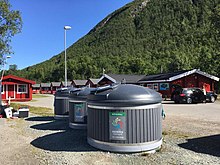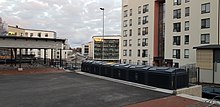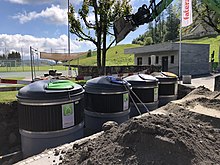Molok (company)
This article contains paid contributions. It may require cleanup to comply with Wikipedia's content policies, particularly neutral point of view. |
| Company type | Osakeyhtiö |
|---|---|
| Founded | 1991 |
| Founder | Veikko Salli |
| Headquarters | Nokia, Finland[1] |
Key people | Marko Penttinen, CEO[2] |
| Products | Molok deep waste collection containers |
| Revenue | 23.1 million euros (2021)[1] |
Number of employees | 84 (2021)[1] |
| Subsidiaries | Molok France, Molok España |
| Website | molok |
Molok Oy is a Finnish company that manufactures and markets deep waste collection containers.[3] In the deep collection system developed by Molok, more than half of the waste containers are underground.[4] Molok is also a registered trademark.
History
[edit]1991–2009
[edit]Veikko Salli founded Molok Oy in 1991.[5] In the 1980s he had worked in the hotel business. Looking at the ugly trash bins in the backyard of his hotel, Salli was thinking aloud what he should do with them. Salli's wife got finally nervous about his reflections and told him to dig them into the ground and that's how the Molok's product idea was initiated.[5] The first prototype Salli designed was made from metal.[6]
In 1993, Molok Oy focused on product development and marketing. There were more than ten Finnish subcontractors participating in the manufacture of its products. The company had a sales network of independent representatives in Finland, Sweden, Norway, Germany, Switzerland, Hungary, Portugal, Australia and the United States. It delivered hundreds of deep collection containers for example to in the Lake Balaton region in Hungary worth several million Finnish markkas.[7]
In 1994, the company's turnover was 12 million markkas, of which exports part was 37%.[8]
In 1995, the company had customers in Belgium, Germany, Switzerland, Austria and the Nordic countries, among others, and it was starting sales in Spain. Molok began manufacturing large parts for Southern European orders in Saint-Malo, France while Molok containers for the Finnish and Central European markets were still made in Finland. During the winter Molok was for example installing several dozen Molok containers in the park areas of Paris and the marina in the Portuguese Algarve. In Finland, Molok products were used for example in the municipalities of Inari, Lavia and Loppi. By the end of 1995, more than 4,000 Molok deep collection containers had been sold.[9]
In 1997, the company's turnover was 20 million markkas and the share of exports was 70%. Its largest market areas were Belgium, Portugal and Spain.[10]
In 1998, Molok introduced a multi-compartment container suitable for sorting many waste fractions. The 1,200-liter container had three or four compartments and was also equipped with a separate biodegrable waste lifting container if needed. There was a separate lifting bag in each compartment and when the container was full, the collection company was notified by telephone. The pilot products were sold to Oulu.[10] In 2001, Molok Oy's turnover was 6 million euros, about one third more than the year before that.[11]
In 2002, Molok manufactured containers for the collection of general waste, paper, glass, small metals and biowaste, as well as for park usage. It employed 22 people in Nokia and Lavia. One of the most significant deals of the year came from Dubai for more than 100 containers worth 300,000 euros.[11]
In 2004, Molok lost the patent protection it had received for its deep collection system in 1988.[12] Molok centralized all its Finnish operations to Nokia and started casting of the container bodies by itself.[13] A 5,000-square-meter hall was built in Nokia for the assembly and product development of deep collection system. The company's management, marketing and finance departments were also located at the same place.[14]
By 2005, Molok had produced over 40,000 deep collection containers. The company employed 35 people and its main market areas were Finland, Sweden, Spain, Brazil, Canada and the United Arab Emirates.[13] The following year the amount of sold containers reached 50,000.[6]
In 2007, the company's production and office facilities were located in Nokia. It also had assembly plants in Canada, Portugal, Belgium and Switzerland.[5]
In 2008, Molok delivered deep collection containers for the Summer Olympics in Beijing.[15]
In 2009, Molok won a long product copy dispute. The company's former representative in France had marketed product copies under the Molok's name and was now sentenced to pay substantial compensation. The Hamburg arbitration court recognized Molok Oy's position as the original developer of the deep collection method and as the official holder of the Molok® brand name.[16] In May 2009, the company participated in the Playful New Finnish Design event during New York Design Week together with Artek, Durat, Marimekko and IVANA Helsinki.[17]
2010–present
[edit]
Hannu Jokinen was appointed as CEO in 2012.[18]
In 2014, Molok acquired Lassila & Tikanoja's deep collection business. It had sold Deepline and Cube deep container product families since 2008.[19]
In 2015, Molok started cooperating with Lujabetoni who produces the reinforced fiber concrete wells to Molok's waste containers.[20] By 2016, the company had delivered about 150,000 waste bins. The company's founder, Veikko Salli, was 80 years old and continued to serve as a member of the Board and as an advisor to the company. His daughter Marja Hillis ran a licensed company manufacturing Molok products in Canada, and his son Jari Salli was one of the owners of the company. The family business needed a new owner and more resources for its international growth. Therefore, 84% of Molok Oy was sold to Vaaka Partners.[3] Simultaneously the company was divided into two parts. The company's industrial premises and warehousing operations were left to the old company, now called Salli Kiinteistöt.[21] Jari Salli started as the Managing Director of Salli Kiinteistöt Oy.[22]
In 2017 Molok turnover was nearly 20 million euros.[23]
In 2019 Molok got its first subsidiary, Molok France.[23] In 2020, Molok España was opened.[24] In August 2020 Marko Penttinen started as a CEO.[2]
Organization
[edit]In addition to its Nokia office and production, Molok Oy operates internationally in more than 40 countries,[13] including sales offices in Belgium and China. It has two subsidiaries, Molok France and Molok España.[25]
Molok Oy has a working culture of a family company and it has divided its production into cells. The cells work independently, which increases employee motivation. Staff benefits include for example trainings and free massages.[15]
Molok North America
[edit]Marja Hillis, nee Salli, the daughter of Molok's founder Veikko Salli, started a licensed company called Molok North America manufacturing Molok products in Canada in the end of the 1990s.[3][26][27] The company and its assembly plant are located in Mount Forest, Ontario.[27][5]
In 2003, Molok started its own collection business in the Kitchener-Waterloo area in Canada.[6]
In 2018 the company operated across Canada and its factory covered 3,000 square meters. Hillis died on March.[27]
In 2019 Raleigh, North Carolina started using Molok's containers being the first city in United States to do so.[28]
In 2020, Molok North America was among the top-400 list of Canada's Top Growing Companies ranked by The Globe and Mail magazine.[29] It has also been on PROFIT 500 list, maintained by Canadian Business magazine ranking Canada's Fastest-Growing Companies in 2013, 2014 and 2015.[30]
Products
[edit]
The Molok deep collection system was developed by the company's founder Veikko Salli.[5] Molok manufactures its deep collection containers based on orders. There are many different designs, as properties have different needs, for example containers need to match their environment as well as possible. 80% of sales come from the four basic models.[25] The main part of the containers is made by a rotational molding machine.[5]
In 2006 the uniform containers were made of thick polyethylene plastic while the top was covered with either pressure-treated wood moldings or aluminum.[6] The company's also sells containers consisting of square containers made of concrete.[20]

The basic idea of deep waste collection is a partially submerged waste container with volumes ranging from 800 liters to 5,000 liters.[8][31] Inside the cool ground, protected from sunlight, the waste is retained longer than normally and it is also packed tightly.[5] This is because of the vertical collection container utilizes gravity, which allows the new waste to compress the waste below into a more compact form. With help of the gravity the collection container can hold more waste.[32]
The advantages of deep collection system are high collection capacity, long emptying intervals, odorlessness [8] and keeping the collection environment clean.[10] Another advantage of Molok products is that it takes up less space above the ground than the traditional rubbish bins, which leaves room for other needs of the residents. Also the amount of waste traffic is decreased as the containers do not need emptying as often than with traditional systems.[5] Odorlessness of the waste is achieved through the heat of the soil: in the North, cool soil cools the debris. In the Middle East the temperature of containers can rise to as high as 60 degrees Celsius, which dries out the waste.[5]
When installing a Molok deep collection system, a pit is dug in the ground to install a waste container. 60% of the Molok container is submerged below the ground level.[32] The container contains a lifting bag or container that is lifted out of the container for emptying using the emptying truck's crane.[5] When emptying, the lifting bag or lifting container opens at its lower end.[33]
Acknowledgements
[edit]- In 1995, Molok became the first foreign waste collection system to pass the German environmental test and to obtain the right to use the eco-label (Umweltzeichen). For example, the low noise level of the use of Molok was mentioned.[9]
- In 2007, Molok received the Pirkanmaa Provincial Entrepreneurship Award [34]
- In 2017, Molok received The Clean Tech Economy Award from The New Economy Magazine[35][36]
References
[edit]- ^ a b c "Molok Oy, Kauppalehti". Kauppalehti (in Finnish). Retrieved 2022-10-03.
- ^ a b "Marko Penttinen - Toimitusjohtaja (Molok Oy) | Kauppalehti". Kauppalehti (in Finnish). Retrieved 2021-03-22.
- ^ a b c Eeva-Riitta Seies. "Molokit maailmalle" [Exporting Moloks]. Talouselämä. Retrieved 2019-12-02.
- ^ "Nokialainen yritys sai 7 miljoonan euron kaupan – Kaikki alkoi, kun asiakkaat valittivat roskien hajusta". Aamulehti (in Finnish). 2018-02-15. Retrieved 2021-04-21.
- ^ a b c d e f g h i j Kuittinen, Teppo. "Nykyaikainen jätekuoppa" [A modern waste pit]. Kauppalehti. Retrieved 2019-12-02.
- ^ a b c d "Deep Collection". Waste & Recycling. Retrieved 2021-03-23.
- ^ "Molok hoitaa jätehuollon Lapista Pustalle" [Molok works from Lapland to Hungary]. Kauppalehti. Retrieved 2019-12-02.
- ^ a b c Riihonen, Risto. "Molok Pariisin puistoihin ja Algarven marinaan" [Molok to parks in Paris and to marine of Algarve]. Kauppalehti. Retrieved 2019-12-02.
- ^ a b "Molok selvitti saksalaistestin" [Molok passed a German test]. Kauppalehti. Retrieved 2019-12-02.
- ^ a b c Riihonen, Risto. "Molok kehitti pientaloille syväkeräyssäiliön" [Molok developed a deep waste collection container for houses in suburban area]. Kauppalehti. Retrieved 2019-12-02.
- ^ a b Riihonen, Risto. "Molok myi syväkeräyssäiliöitä Dubaihin" [Molok sold deep waste collection containers to Dubai]. Kauppalehti. Retrieved 2019-12-02.
- ^ "Jätelaitevalmistaja Molok menetti patenttinsa". Ilta-Sanomat (in Finnish). 2004-03-18. Retrieved 2021-04-21.
- ^ a b c Riihonen, Risto. "Molok vie ympäristötekniikkaa Brasiliaan" [Molok is exporting environment technology to Brazil]. Kauppalehti. Retrieved 2019-12-02.
- ^ "Molok muuttaa Nokialle" [Molok moves to Nokia]. Kauppalehti. Retrieved 2019-12-02.
- ^ a b Jaatinen, Martti. "Jätteiden syväkeräyksen edelläkävijä" [The pioneer in deep waste collection container systems]. Kauppalehti. Retrieved 2019-12-02.
- ^ "Molok voitti tuotekopiokiistan". Yle Uutiset (in Finnish). Retrieved 2019-12-02.
- ^ "Suomalainen muotoilu esittäytyy New Yorkin Designviikolla". KSML.fi – Keskisuomalainen (in Finnish). Retrieved 2019-12-02.
- ^ Hartikainen, Jarno. "Jäteastiafirman toimitusjohtaja vaihtuu" [Rubbish bin company is changing its CEO]. T Kauppalehti. Retrieved 2019-12-02.
- ^ "Molok ostaa Lassila & Tikanojan syväsäiliöt" [Molok buys deep collection business from Lassila & Tikanoja]. Talouselämä (in Finnish). Retrieved 2019-12-02.
- ^ a b Vehviläinen, Maija. "Lujabetoni ja Molok yhteistyöhön" [Lujabetoni and Molok start cooperation]. Kauppalehti. Retrieved 2019-12-02.
- ^ Ranta, Elina (2017-10-22). "Veikko Salli, 81, loi roskiksista menestysbisneksen – "Olen urallani moneen kertaan suistunut ja ylös noussut"" [Veikko Salli, 81 years, created a successful business out of garbage - "There has been many ups and downs in my career"]. Ilta-Sanomat (in Finnish). Retrieved 2019-12-02.
- ^ "Salli Kiinteistöt Oy, Kauppalehti". Kauppalehti (in Finnish). Retrieved 2019-12-04.
- ^ a b "Nokialainen Molok Oy perustaa tytäryhtiön Ranskaan – pyrkii tehostamaan kierrätystä" [Molok Oy from city of Nokia is opening a subsidiary in France - aims to enhance recycling]. www.aamulehti.fi (in Finnish). Retrieved 2019-12-09.
- ^ "Póngase en contacto con nosotros — Molok". www.molok.com (in Spanish). Retrieved 2020-07-22.
- ^ a b Tervola, Janne. "Molok tekee tarjouksen odottaessa – myyjä konfiguroi tuotteen asiakkaan luona" [Molok makes the offer while you wait - the seller configurates the product while visiting a customer]. Tekniikkatalous. Retrieved 2019-12-02.
- ^ Aarts, Deborah (2016-08-29). "Molok North America CEO Marja Hillis on how to fire your spouse". Canadian Business - Your Source For Business News. Retrieved 2021-04-16.
- ^ a b c "Marja Hillis os. Salli muistetaan Nokialla liikuntakeskusyrittäjänä". Nokian Uutiset (in Finnish). 2018-03-29. Retrieved 2021-04-16.
- ^ Johnson, Anna (2019-05-28). "Raleigh goes underground to find stink-free solution to downtown trash carts". The News&Observer. Retrieved 2021-04-19.
- ^ "Molok North America Ltd. places No. 365 on The Globe and Mail's second-annual ranking of Canada's Top Growing Companies". Waste Advantage Magazine. 2020-09-25. Retrieved 2021-03-23.
- ^ "Molok North America Ltd. Ranks on the 2015 PROFIT 500 for the Third Year in a Row". Waste Advantage Magazine. 2015-09-21. Retrieved 2021-03-23.
- ^ "MolokClassic | Underground waste bin". www.molok.com. Retrieved 2020-08-05.
- ^ a b "Roska-astiat muuttuivat älykkäiksi: Auringon voima litistää jätteet murto-osaan alkuperäisestä tilavuudestaan" [Trash cans became smart: the power of the sun flattens waste to a fraction of its original volume]. Yle Uutiset (in Finnish). Retrieved 2019-12-02.
- ^ "Taloyhtiön siisti ja toimiva jätteidenkeräys" [Clean and efficient waste collection of the properties]. Omataloyhtiö.fi (in Finnish). 2010-10-14. Retrieved 2019-12-04.
- ^ "Yrittäjäpalkinto upposi Molokin kitaan" [Molok got an entrepreneurship award]. Ilta-Sanomat (in Finnish). 2007-10-20. Retrieved 2019-12-02.
- ^ "Molok Bucks Global Waste Giants and Wins New Economy Clean Tech Award for Best Recycling and Waste Management Solutions". Waste Advantage Magazine. 2017-01-11. Retrieved 2019-12-02.
- ^ "Molokille The New Economy Award -palkinto innovatiivisuudesta – Projektiuutiset.fi" [Molok got The New Economy Award for its innovativeness] (in Finnish). 15 February 2018. Retrieved 2019-12-02.
External links
[edit]- Official website
- Molok North America
- The New Economy interview: "Burying bins: How Molok's vertical waste management swept the globe Molok" with founder Veikko Salli and CEO Marja Hillis
